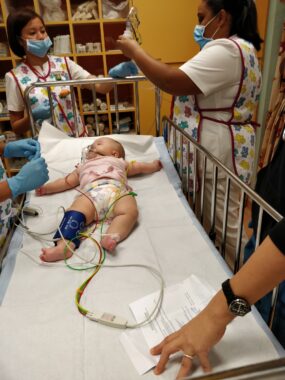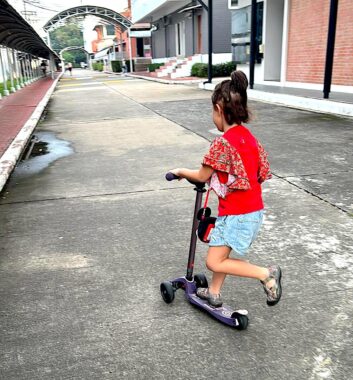Our daughter’s rebirth day is an annual reminder of hope
How gene therapy has proven to be transformative for our family
Written by |

Rebirth is a common theme that appears in such classic stories as “Sleeping Beauty,” “Beauty and the Beast,” “A Christmas Carol,” and “The Lion King.” The idea holds a special place in the psyche of humans and, especially, in our rare disease community.

In 2018, Rylae-Ann was first admitted to intensive care. What followed were months of her fighting for her life as her parents tried to discover what was wrong. (Photo by Richard E. Poulin III)
Stories of rebirth typically feature a journey through hardship and challenges before the hero overcomes adversity through change, renewal, or transformation. In our actual story, our daughter, Rylae-Ann, was born with the rare disease aromatic l-amino acid decarboxylase (AADC) deficiency. Thankfully, she had gene therapy exactly four years ago, on Nov. 13, 2019. The results were life-changing, and that’s why we refer to that date as her reborn day.
Rebirth
Everyone in our AADC deficiency community whose children have been fortunate enough to undergo this novel therapy refers to the surgery date as their child’s rebirth date. This labeling of the momentous occasion happened spontaneously and independently. I believe it’s because the results have been so transformational that no better word exists. Rebirth describes the day the best.
When our daughter was 18 months old, she was fighting for her life and unable to move. At 19 months old, one month after surgery, her eyes were open, she began reaching for objects, and she sat upright. Today, at 5 years old, she enjoys riding horses, cruising on her scooter, and swimming.
The idea of rebirth brings hope to many in the rare disease community or challenging situations. It offers a dream of escaping a traumatic experience and awakening to a new beginning.
Unfortunately, this gene therapy, Upstaza (eladocagene exuparvovec), is only approved in the United Kingdom and elsewhere in Europe. We’ll continue to advocate for its approval by the U.S. Food and Drug Administration for our friends in the United States.
Mental health rebirth

This month, four years after gene therapy, Rylae-Ann cruises on her scooter, making her way to school independently. (Photo by Richard E. Poulin III)
My wife, Judy, and I had traversed a long, dark, and bumpy road with mental health before that journey brought us to a beautiful destination. It took time and support. After we died inside from the initial, devastating news, Judy and I fought together to rise from the ashes. We found ourselves, better understood our daughter, and loved our new life.
There is a helpful lesson I regularly come across living in Thailand, a predominantly Buddhist country: Rebirth is always possible, regardless of where you and your child are on your journey. It’s a continuous part of our lives. But rebirth is not just about birth and death. Instead, we’re always reborn at every moment as we seek to improve our lives, make positive changes, and create solutions.
Overcoming life’s challenges in the rare disease community and improving your mental health are forms of rebirth. As we celebrate our daughter’s reborn day, we continue to advocate for other children to have this lifesaving treatment and encourage all parents to rise from their ashes to continue their journey to amazing destinations.
Note: AADC News is strictly a news and information website about the disease. It does not provide medical advice, diagnosis, or treatment. This content is not intended to be a substitute for professional medical advice, diagnosis, or treatment. Always seek the advice of your physician or other qualified health provider with any questions you may have regarding a medical condition. Never disregard professional medical advice or delay in seeking it because of something you have read on this website. The opinions expressed in this column are not those of AADC News or its parent company, Bionews, and are intended to spark discussion about issues pertaining to aromatic l-amino acid decarboxylase deficiency.






Leave a comment
Fill in the required fields to post. Your email address will not be published.